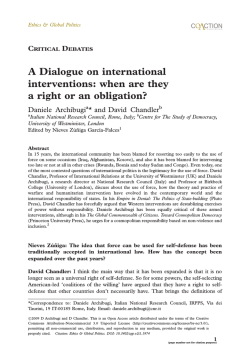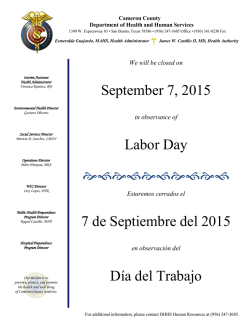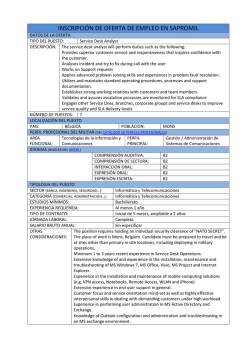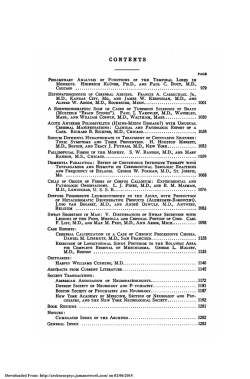
Document
STYLE SHEET Hispanic American Historical Review HAHR follows The Chicago Manual of Style (16th edition) and Merriam-Webster’s 11th Collegiate Dictionary in spelling, hyphenation, italicization, capitalization, use of numbers, punctuation, and other matters of style. In English text, italics are used at first occurrence for unfamiliar foreign words, that is, words that do not appear in Merriam-Webster’s 11th Collegiate Dictionary. Italics are not used for proper nouns. Italics can also indicate words used as words: e.g., the Spanish verbs ser and estar are both rendered by “to be.” Names of persons mentioned in text should be given in full at first use. Acronyms can be used only after the full name of the organization is given and the acronym defined. E.g., Office of Inter-American Affairs (OIAA); Delegación de Asociaciones Israelitas Argentinas (DAIA) Quotations should correspond exactly to the originals in wording, spelling, interior capitalization, and interior punctuation. Extracts (block quotations) should be used for quoted material of approximately 80 words or more. Shorter quotations should be run in to the body of text. Observe the distinction between 3-point and 4-point ellipses. Indicate omissions within a quoted sentence by three spaced periods. When the omitted passage includes the end of a sentence, indicate the ellipsis by four periods with no space before the first. Ellipsis points are seldom necessary at the beginning or end of a quoted passage, since the reader normally assumes that something precedes and follows any quotation. (See The Chicago Manual of Style, 13.48–56.) Interpolations of words or comments by the author into quoted matter should be enclosed in square brackets, not parentheses. Such interpolations should be kept to a minimum. Numbers from 1 to 10 are spelled out; use numerals for larger numbers. Use numerals to express percentages: “3 percent.” Page citations should appear as 445–47, not 445–447 or 445–7. The same applies to year citations, except in titles and headings. (See The Chicago Manual of Style, 9.60, 9.63.) Dates take the following form in the body of the text: September 4, 1951. (In notes, dates take the form 4 Sept. 1951.) Names of centuries are spelled out: “in the seventeenth century” (noun); “seventeenth-century documents” (adj.). Abbreviations Ibid. (used in roman type) refers to the item preceding and takes the place of as much of the succeeding material as is identical. Ibid. cannot be used when more than one citation has been given in the preceding note. Op. cit., loc. cit., and idem are not used. For repeated citations use the author’s last name, the main title minus any subtitle, and pages. Specific pages should be cited whenever possible; otherwise the whole book or article should be cited. Use of passim and ff. is discouraged. Omit the abbreviations p. and pp. unless the page number immediately follows another number (as in the date of a newspaper citation or in certain archival references). In notes, abbreviate names of months except May, June, and July, e.g., 4 Sept. 1951. Tables and Figures Each table should be identified by both a number and a descriptive title. The author should identify all sources used and indicate where each table should be placed in the text. The Chicago Manual of Style discusses table format and style in chapter 3 (3.46–85). Figures (illustrations) are numbered separately from tables, and they also must be identified by descriptive captions. The source for each figure should be identified, and the author should clearly indicate where each figure should be placed in the text. If the article is accepted for publication, the author is responsible for obtaining permission to reprint the images and for supplying camera-ready or high-resolution (300 dpi minimum) digital copies of the figures. Image quality is a frequent concern: 72 dpi images copied from the Web or photocopies of newspaper photos, for example, reproduce very poorly. Notes / Reference list Notes should be prepared within the word processing software, for example by inserting a footnote in Word; please do not use any special bibliographic software such as EndNote. HAHR employs a hybrid citation style taken from The Chicago Manual of Style (16th edition). Notes are used to cite sources referred to in the course of the text; texts listed in these notes, with the exception of newspapers and archival sources, should always be given in the shortened form described in The Chicago Manual of Style 14.24–31. This is supplemented with a reference list at the end of the essay, where works are cited in full using author-date format, as described in The Chicago Manual of Style 15. This reference list should be arranged alphabetically by author’s last name; in the case that multiple works by a single author are included, please arrange these by publication date in ascending order, with undated works designated n.d. or forthcoming following all dated works and a 3-em dash replacing the author’s name in all references after the first work cited by the author. Below are specific examples of what this formatting style looks like for various sources. Books Reference list citation: Adelman, Jeremy. 1994. Frontier Development: Land, Labour, and Capital on the Wheatlands of Argentina and Canada, 1890–1914. New York: Oxford University Press. Note citation: Adelman, Frontier Development, 122–23. Reference list citation: O’Phelan Godoy, Scarlett, and Mónica Ricketts, eds. 2004. Homenaje a Jorge Basadre: El hombre, su obra y su tiempo. Lima: Pontificia Universidad at lica del er , nstituto i a- g ero ni ersidad del ac ico nstituto ultural eruano orteamericano. Note citation: O’Phelan Godoy and Ricketts, Homenaje a Jorge Basadre, vi. Citing multiple texts by the same author Reference list citation: Andrews, George Reid. 1991. Blacks and Whites in São Paulo, Brazil, 1888–1988. Madison: University of Wisconsin Press. Andrews, George Reid. 2004. Afro-Latin America, 1800–2000. Oxford: Oxford University Press. Note citation: Andrews, Blacks and Whites, 24. Andrews, Afro-Latin America, 46–49. Citing texts with date of original publication: Reference list citation: López de Gómara, Francisco. (1552) 1991. Historia general de las Indias y vida de Hernan Cortés. Edited by Jorge Gurria Lacroix. Caracas, Venezuela: Biblioteca Ayacucho. Note citation: López de Gómara, Historia general de las Indias, 127–29. Copublished books: Marichal, Carlos. 1999. La bancarrota del virreinato: Nueva España y las finanza del imperio español, 1780–1810. Mexico City: El Colegio de ico ondo de ultura con mica Note citation: Marichal, La bancarrota del virreinato, 27–32. Book chapters Reference list citation. Burkett, Elinor C. 1979. “Indian Women and White Society: The Case of Sixteenth-Century Peru.” In Latin American Women: Historical Perspectives, edited by Asunción Lavrin, 101–28. Westwood, CT: Greenwood Press. Note citation: Burkett, “Indian Women and White Society,” 111–17. If the edited collection containing an article has already been cited in the reference to another article, the citation of that subsequent article can use a shortened citation to the collection, e.g.: Benton, Lauren 2012 “ ossessing mpire: berian laims and nterpolity Law ” n Native Claims: Indigenous Law against Empire, 1500–1920, edited by Saliha Belmessous, 19– 40. Oxford: Oxford University Press. itzmaurice, ndrew 2012 “ owhatan Legal laims ” In Belmessous 2012, 85–106. Note citation: Benton, “ ossessing mpire,” 27 itzmaurice, “ owhatan Legal laims,” 89 Citation of multivolume works Reference list citation: Lohmann Villena, Guillermo and María Justina Sarabia Viejo, eds. 1986–89. Francisco de Toledo: Disposiciones gubernativas para el virreinato del Perú, 1575–1580. 2 vols. Seville: Escuela de Estudios Hispano-Americanos. Note citation: Lohmann Villena and Sarabia Viejo, Francisco de Toledo, 2:237–38. Citation of a single volume: Reference list citation: Socolow, Susan, ed. 1996. Commerce and Politics. Vol. 1 of The Atlantic Staple Trade. Brookfield, VT: Variorum. Forment, Carlos A. 2003. Civic Selfhood and Public Life in Mexico and Peru. Vol. 1 of Democracy in Latin America 1760–1900. Chicago: University of Chicago Press. Note citation: Socolow, Commerce and Politics, 47. Forment, Civic Selfhood and Public Life, 24. Unpublished PhD dissertations Reference list citation: Garner, ichard L 1970 “Zacatecas, 1750–1821: The Study of a Late olonial PhD diss., University of Michigan. Note citation: Garner, “Zacatecas, 1750–1821,” 56 e ican ity ” Journals Reference list citation: Casey, Matthew. 2011. “Haitians’ Labor and Leisure on uban Sugar Plantations: The Limits of Company Control.” New West Indian Guide / Nieuwe West-Indische Gids 85, no. 1–2: 5– 30. Restall, Matthew 2003 “ History o the ew hilology and the New Philology in History ” Latin American Research Review 38, no. 1: 113–34. Suárez Bilbao, Fernando. 1997. “La costumbre indígena en el derecho indiano.” Studia Carande (Madrid) 1: 99–130. Note citation: asey, “Haitians’ Labor and Leisure,” 10–11. estall, “History o the ew hilology,” 115 Suárez Bilbao, “La costumbre ind gena,” 100–102. Newspapers and magazines Do not include newspapers in the reference list. Note citation: La Prensa (Managua), 10 Oct. 1946, p. 7. Include title and author if available. Interviews Identify person interviewed, interviewer, and place and date of interview within the note citation. Do not include such sources in the reference list. Archival sources Do not include such sources in the reference list. If you will be citing and abbreviating many different archives, you may include a list of abbreviations at the beginning of your notes. Cite archival sources only in the note citations, not in the reference list. Manuscript citations should always include an identification of the document (which will usually include a date), the name of the collection containing the document, and the repository and city where the document is located; whenever possible identify boxes and/or files within the collection by name or number. Examples: Domingo Faustino Sarmiento to Juan Pujol, Buenos Aires, 22 May 1860, Archivo General de la Nación, Buenos Aires, Archivo del General Justo José de Urquiza (hereafter cited as AGN, Urquiza), leg. 67. Subsequent citation: Sarmiento to Pujol, Buenos Aires, 22 May 1860, AGN, Urquiza, leg. 67. Lefebre de Bécourt to Minister of Foreign Affairs, Mexico City, 23 Sept. 1861, Archives du Département des Affaires Étrangères, Paris (hereafter cited as AAE), Correspondance Politique (hereafter cited as CP), vol. 38, fol. 231. Subsequent citation: Lefebre de Bécourt to Minister of Foreign Affairs, Mexico City, 23 Sept. 1861, AAE, CP, vol. 38, fol. 231. Land grant in favor of Pedro de Avila y Zárate, Talavera, 1697, Archivo Histórico de Tucumán (hereafter cited as AHT), Protocolos, ser. A, box 3. Property title of Juan Román, Tucumán, 1697, AHT, Protocolos, ser. A, box 3. Juan Ramírez de Velazco to Consejo de Indias, Salta, 20 Apr. 1588, Archivo General de Indias, Sevilla, Audiencia de Charcas (hereafter cited as AGI, Charcas), leg. 26, doc. 1. Conference on actions to be taken in the Calchaquí Valley (Junta en que se trató las consecuencias y ejecuciones que habían de tener en Valle Calchaquí), San Juan de la Rivera, 4 Aug. 1657, AGI, Charcas, leg. 122. Terms black church conquest crown don, doña (in accordance with Spanish usage) preconquest
© Copyright 2025



